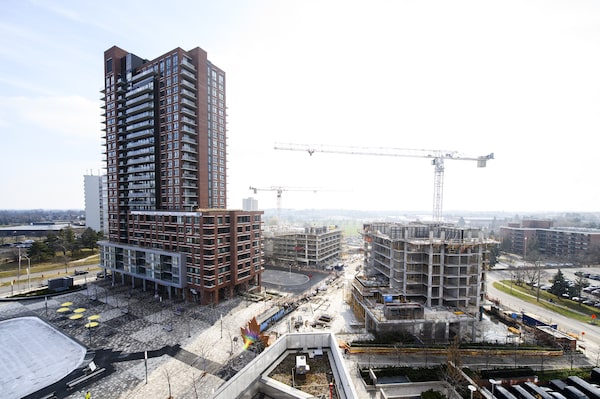
Condo construction is shown in Ajax, Ont., on Nov. 30, 2023.Christopher Katsarov/The Canadian Press
Build, build, build has become a common political incantation when it comes to tackling the country’s housing crisis.
There is a slew of new policies and proposals for incentivizing and speeding up the construction of condo towers, apartment buildings, multiplexes and townhomes. And that’s good: The country desperately needs more of all those types of housing.
But in the scramble to build housing, is Canada building enough homes? Canadians, by and large, continue to think of condos and apartments as housing, not homes.
That’s hardly surprising given the way Canada builds them: small units in tall towers clustered in downtown cores or near busy transit hubs. They’re the one- and two-bedrooms young people rent in their 20s (and, increasingly, their 30s). The starter homes. The initial landing spot for newcomers.
But they are not desirable homes for two large swaths of the population. Young families need multiple bedrooms and proximity to parks and schools. Retirees looking to downsize often say they want to remain in the same neighbourhood.
A dearth of higher-density homes for these two groups has dire consequences for cities.
Young parents without the family money or the high incomes needed to afford a house in the city are moving ever further afield in search of more space at lower prices. The risk is a growing exodus of essential, middle-class, mid-career workers from expensive urban markets. At the same time, many seniors are reluctantly holding on to large and mostly empty homes for lack of appealing downsizing options.
So why isn’t Canada building condos and apartments that can be family- and senior-friendly homes? The answer is that zoning and building code rules have long made building these sorts of units financially unviable.
For the past century, cities have severely limited areas designated for multi-unit dwellings. This enforced an artificial scarcity of land for these projects, which inflated its value.
Expensive land, in turn, generates an incentive for developers to build many units on it, which reduces the cost of land per square foot of floor space.
Steep construction costs and civic development taxes also add to the tally on which builders must turn a profit. But there’s only so much that condo buyers and renters can afford, or are willing to pay, for a unit in a condo tower or large apartment building.
Often, three bedrooms are so expensive that people can easily buy or rent a townhouse farther away from downtown at similar rates. That’s how one ends up with tall towers crammed with tiny units.
Happily, these zoning restrictions are starting to, in part, ease. Federal policy now encourages cities to build four units on land previously designated for one or two homes, something B.C. recently allowed provincewide in most communities. These changes dramatically increase the supply of land potentially available for multi-unit housing without requiring developers to go through the costly and lengthy hassle of a rezoning application.
But a real game changer, experts and advocates say, would be to extend those rules to six-storey buildings. This would allow considerably more floor space per small parcel of land, resulting in lower land costs per square foot.
At the same time, six-storey structures are still small enough that they can be built with a wooden frame, cheaper per square foot than the concrete construction required for high-rises.
Add to that another rule book tweak this space hailed in May and made official in B.C. in August. The province now allows buildings of up to six floors to have only one set of stairs, instead of two, as commonly required by outdated fire-safety standards.
A single-stair, six-storey multiplex on a typical residential lot could fit a dozen units of 1,000 to 1,300 square feet, reckons Bryn Davidson, at Vancouver-based Lanefab Design/Build. At the upper end of that range you can build a three-bed, two-bath unit, which would work for a family, he says.
The idea that condos and apartments are second-class housing in soulless mega buildings is deeply ingrained in the North American psyche. But large, comfortable flats in smaller buildings are the norm in European cities – not just housing, but a place to call home.